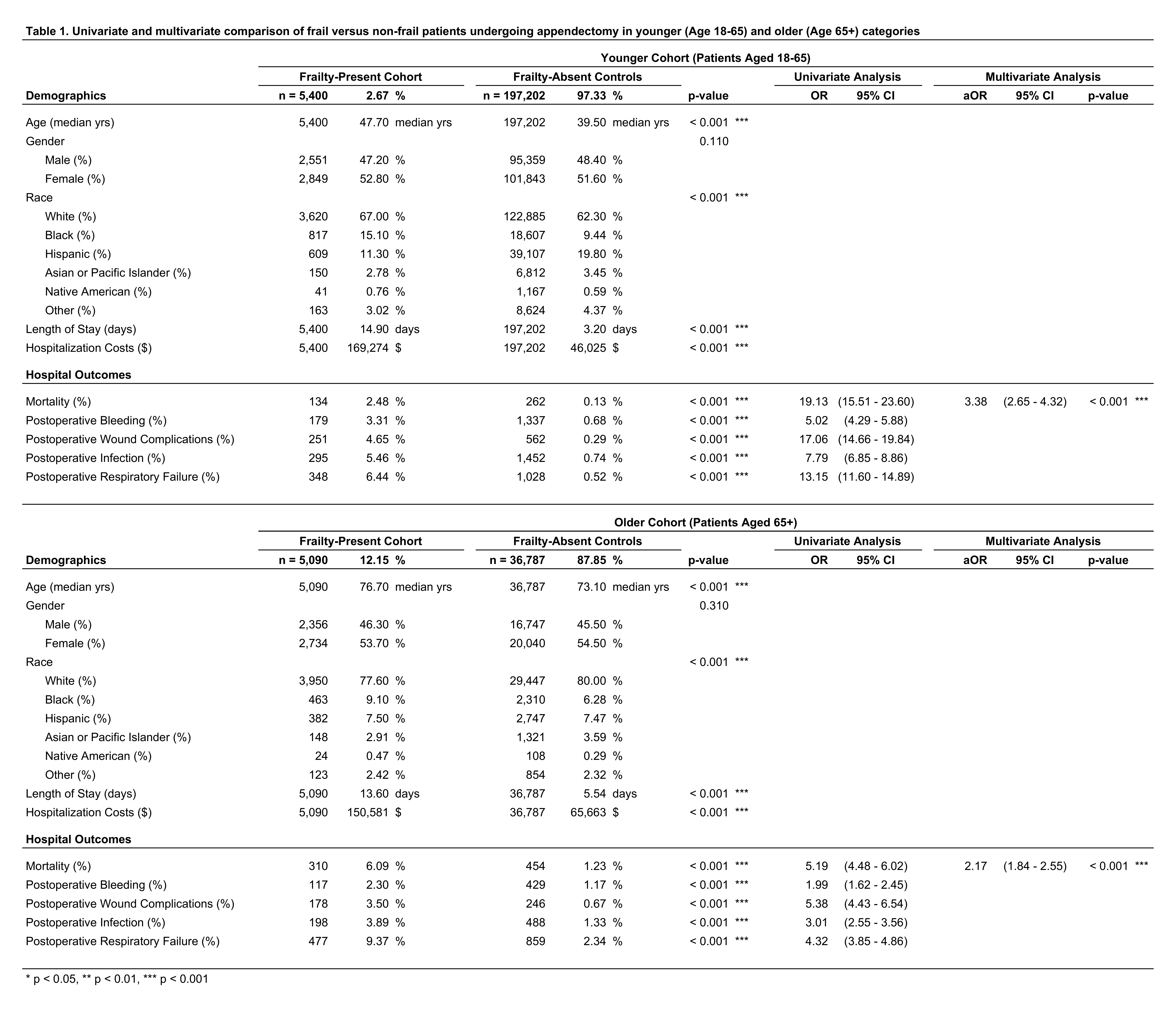THE CLINICAL IMPACT OF FRAILTY ON THE POSTOPERATIVE OUTCOMES OF PATIENTS UNDERGOING APPENDECTOMY: ANALYSIS OF 2011-2017 US HOSPITALS
David U. Lee*, Gregory H. Fan, Raffi Karagozian
Tufts Medical Center, Boston, MA
Background & Aims: Frailty is a well-established prognostic indicator of adverse postoperative outcomes in patients undergoing various surgeries. In this study, we use a national registry of hospitalized patients to systematically analyze the effect of frailty on the postoperative outcomes of patients undergoing appendectomies.
Methods: The 2011-2017 National Inpatient Sample was used to identify inpatient cases of appendectomy, which were further divided by age category: younger (65>age>18) and older (age>=65). Each age category was further sub-stratified by frailty as defined by Johns Hopkins frailty diagnostic indicators that were expressed as a single composite variable. The study endpoints included mortality, length of stay, hospitalization costs, and postoperative complications.
Results: Of the appendectomy cases identified from the database, there were 202602 in younger age category and 41877 in older age category. In younger age category, there were 5400 with frailty and 197202 without frailty. The frail cohort was older (47.7 vs 39.5y p<0.01), but no difference was found in gender distribution (female: 52.8 vs 51.6% p=0.11). Mortality was higher in the frail cohort (2.48 vs 0.13% p<0.01, OR 19.1 95%CI 15.5-23.6), as were LOS (14.9 vs 3.20d p<0.01) and hospitalization costs ($169,274 vs $46,025 p<0.01). In terms of postoperative complications, the frail cohort had higher rates of bleeding (3.31 vs 0.68% p<0.01, OR 5.02 95%CI 4.29-5.88), wound complications (4.65 vs 0.29% p<0.01, OR 17.1 95%CI 14.7-19.8), infection (5.46 vs 0.74% p<0.01, OR 7.79 95%CI 6.85-8.86), and respiratory failure (6.44 vs 0.52% p<0.01, OR 13.1 95%CI 11.6-14.9). In multivariate model, frailty was associated with higher mortality (p<0.01, aOR 3.38 95%CI 2.65-4.32). In older age category, there were 5090 with frailty and 36787 without frailty. The frail cohort was older (76.7 vs 73.1y p<0.01) and was more likely to be female (53.7 vs 54.5% p=0.31). Mortality was higher in the frailty cohort (6.09 vs 1.23% p<0.01, OR 5.19 95%CI 4.48-6.02), as were LOS (13.6 vs 5.54d p<0.01) and hospitalization costs ($150,581 vs $65,663 p<0.01). In terms of postoperative complications, the frail cohort had higher rates of bleeding (2.30 vs 1.17% p<0.01, OR 1.99 95%CI 1.62-2.45), wound complications (3.50 vs 0.67% p<0.01, OR 5.38 95%CI 4.43-6.54), infection (3.89 vs 1.33% p<0.01, OR 3.01 95%CI 2.55-3.56), and respiratory failure (9.37 vs 2.34% p<0.01, OR 4.32 95%CI 3.85-4.86). In multivariate model, frailty was associated with higher mortality (p<0.01, aOR 2.17 95%CI 1.84-2.55).
Conclusion: In patients undergoing appendectomies, frailty poses an increased postoperative risk in terms of mortality and complications. Patients with frailty should thus receive an in-depth analysis of their postoperative risks, followed by close surveillance and prompt treatment of postsurgical complications.
This figure demonstrates the multivariate model evaluating the effect of frailty on postoperative mortality in younger (18-65) and older (65+) patients undergoing appendectomy
This table demonstrates the univariate and multivariate comparison of frail to non-frail patients undergoing appendectomy in younger (18-65) and older (65+) categories
Back to 2021 Abstracts
